Haybox cookers use retained heat to cook the food and save energy. They are also very convenient as food can be prepared and kept hot for hours and then served up when needed. This can be great when having friends for a meal – you can relax and have a drink and then magically produce the meal from within a box or a basket.
But what precautions have to be taken with food safety? Is the growth of bacteria in food kept at 40 to 50 deg C going to be an issue with haybox cooking? We looked into this by monitoring the temperature of the food as it slowly cooked in the haybox. The graph below shows what happened when we cooked ratatouille.
 (Click graph for larger version)
(Click graph for larger version)
The initial temperature wasn’t quite the 100 deg C we were expecting. This was probably due the fact that there was not much water when we put it in the haybox – most of the liquid comes from the vegetables as they cook. The start temperature was around 95 deg C at around 14.50. It looks like on average we get a temperature drop of around 10 deg C per hour. This is slightly higher in the first few hours and flattens off as time goes on. But 10 deg per hour seems to be a good ‘rule of thumb’.
Nearly 3 and a half hours later, when we were ready to eat, the temperature was just under 60 deg C which was just right – there was no need to warm this up. It went straight to the table to eat with some mixed rice that was cooking in another haybox cooker.
In the UK, 9 to 62 deg C is regarded as the danger zone for bacterial growth. As the ratatouille was only in this region for such a short period, there is little risk of bacterial growth and it was safe to eat.
In practice when food is cooked in a well insulated haybox, it should be safe to eat even after 5 hours when the temperature should be around 50 deg C. Most people would consider this hot to the lips and would not bother to reheat it.
The advice from the Apprevecho Research Centre on food safety when cooking in a haybox is:
“Bacterial poisoning can be avoided by two simple steps. Make sure that the food is initially boiled for at least 5 minutes. Then keep the lid closed from that point on and always re-heat meat dishes before serving.”
Here’s the recipe we used:
Ratatouille

Ingredients:
Olive oil
2 onions sliced
3 cloves garlic – crushed
1 aubergine – chopped into 1” cubes
3 courgettes – chopped into 1” cubes
2 peppers – chopped into 1” cubes
½ tin chopped tomatoes or 3 fresh tomatoes chopped
Salt
Black pepper
Instructions:
Heat olive oil in a pan.
Add onions and garlic and fry 5 minutes
Add all other ingredients and cook 5 – 10 minutes with lid on
Season to taste
Place in pot for one and a half hours to cook
Will stay hot for up to 5 hours

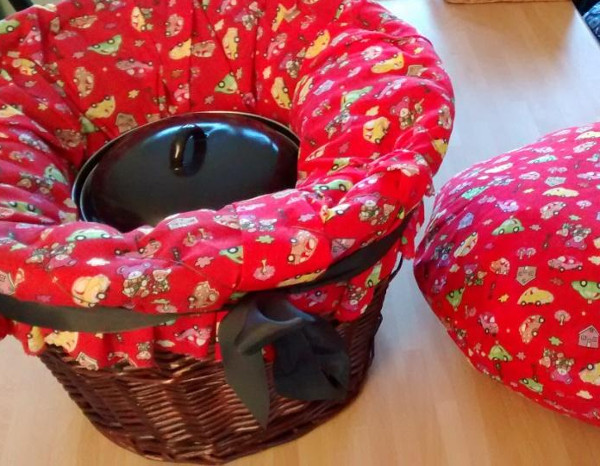
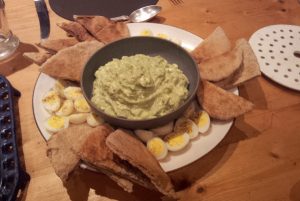
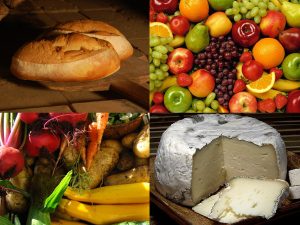
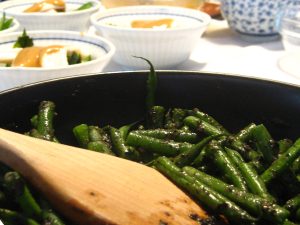
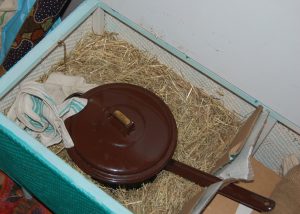
4 Comments
Haybox cooking has been around for well over 100 years. It was heavily promoted during WW2 by the government as it reduced fuel use which was particularly useful after an air raid when gas pressure could be down and electricity supplies disrupted. It also enabled a meal to be cooked whilst the housewife was out working.
The modern version, the slow cooker, is pretty economical being thermostatically controlled and takes up a lot less room.
The results with both haybox and slow cookers are excellent – it gets the best out of tough, cheap cuts of meat making them tender and richly flavoured.
We’ve quite a few tried and tested recipes on our web site: http://www.lowcostliving.co.uk/food/recipes/category/slow-cooking/
Those recipes for the slow cooker look really good. The haybox does come into its own when there is no easy access to electricity like when camping. Also useful for transporting hot food in the car – it will keep hot over a 3 to 4 hours journey and still be piping hot when served.
They keep working in a power cut too!
Just a thought – there’s an interesting book on Haybox cooking from 1913 – Fireless Cooking – I think it’s still available from Google Books as a pdf. If you want a copy and can’t find it, just contact me.